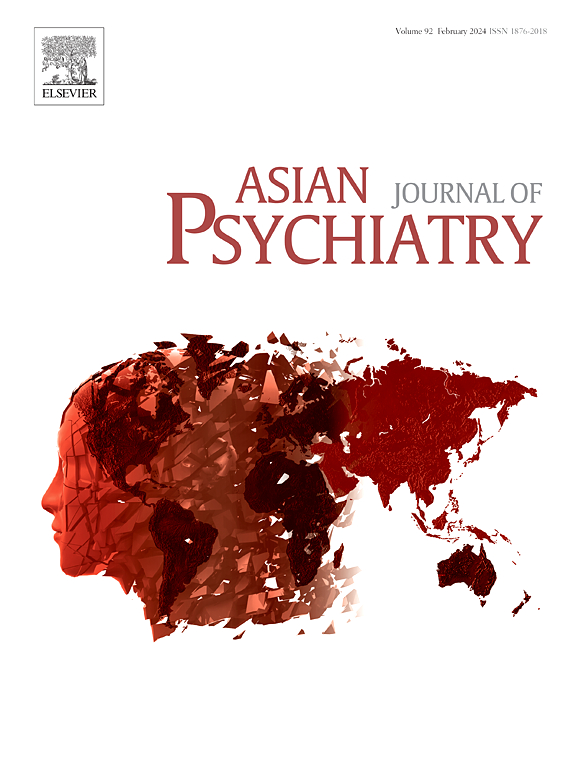Predictors of response and remission after transcranial magnetic stimulation for major depressive disorder: An international comparative study between Taiwan and Japan
IF 4.5
4区 医学
Q1 PSYCHIATRY
引用次数: 0
Abstract
Background
This study aimed to identify demographic, clinical, and protocol-related predictors of effectiveness of transcranial magnetic stimulation (TMS) therapy in patients with major depressive disorder (MDD) across Taiwan and Japan.
Methods
This retrospective observational study analyzed clinical data collected between September 2023 and August 2024 from patients with MDD treated either repetitive TMS or theta-burst stimulation at two institutes in Taiwan and one in Japan. All patients were assessed using the Hamilton Depression Rating Scale (HAMD) before and after a course of TMS treatment. Variables were assessed for their association with response, remission, and change of HAMD scores from baseline using a multiple logistic and linear regression model.
Results
205 patients (131 Taiwanese and 74 Japanese) were included. The Taiwanese population had a significantly higher percentage of females than the Japanese population (71.0 % vs. 42.5 %). Being married (adjusted odd ratios [aOR] = 2.339) and being employed (aOR = 2.048) were more likely to achieve a response, whereas current alcohol use (aOR = 0.332) was less likely to be associated with response. Additionally, patients who were employed (aOR = 2.183) were more likely to achieve remission, whereas those with a longer duration of illness (aOR = 0.938) and current alcohol use (aOR = 0.310) were less likely to reach remission. Furthermore, being female, being married, being employed, and higher baseline HAMD were more likely having greater reductions in HAMD scores.
Conclusions
This study suggests the specific predictors when predicting the treatment outcome of TMS for MDD patients in Taiwan and Japan.
经颅磁刺激治疗重性抑郁障碍的反应与缓解预测因素:台湾与日本之国际比较研究
背景:本研究旨在探讨台湾和日本经颅磁刺激(TMS)治疗重度抑郁症(MDD)的人口学、临床和治疗方案相关预测因素。方法本回顾性观察性研究分析了台湾两个研究所和日本一个研究所于2023年9月至2024年8月期间收集的MDD患者的临床数据,这些患者接受重复性经颅磁刺激或theta-burst刺激。所有患者在经颅磁刺激治疗前后均采用汉密尔顿抑郁评定量表(HAMD)进行评估。使用多元逻辑和线性回归模型评估变量与反应,缓解和HAMD评分从基线变化的关系。结果共纳入205例患者(台湾131例,日本74例)。台湾人口的女性比例明显高于日本人口(71.0 % vs. 42.5 %)。已婚(调整后的奇数比[aOR] = 2.339)和在职(aOR = 2.048)更有可能获得应答,而当前饮酒(aOR = 0.332)与应答的关联较小。此外,受雇的患者(aOR = 2.183)更有可能达到缓解,而病程较长的患者(aOR = 0.938)和目前饮酒的患者(aOR = 0.310)不太可能达到缓解。此外,女性、已婚、在职和较高的基线HAMD更有可能在HAMD得分上有更大的下降。结论本研究提示台湾和日本经颅磁刺激治疗重度抑郁症患者疗效的具体预测因素。
本文章由计算机程序翻译,如有差异,请以英文原文为准。
求助全文
约1分钟内获得全文
求助全文
来源期刊

Asian journal of psychiatry
Medicine-Psychiatry and Mental Health
CiteScore
12.70
自引率
5.30%
发文量
297
审稿时长
35 days
期刊介绍:
The Asian Journal of Psychiatry serves as a comprehensive resource for psychiatrists, mental health clinicians, neurologists, physicians, mental health students, and policymakers. Its goal is to facilitate the exchange of research findings and clinical practices between Asia and the global community. The journal focuses on psychiatric research relevant to Asia, covering preclinical, clinical, service system, and policy development topics. It also highlights the socio-cultural diversity of the region in relation to mental health.
 求助内容:
求助内容: 应助结果提醒方式:
应助结果提醒方式:


